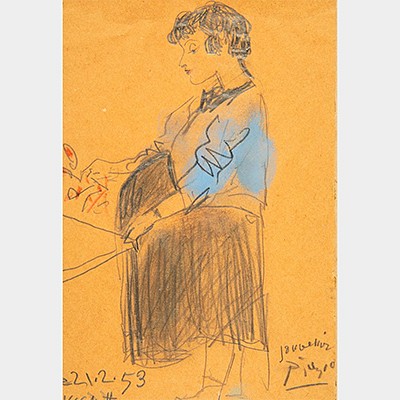JAUME PLENSA (Barcelona, 1955). "Cara", 2003. Silicone and collage on cardboard. Signed and dated in the lower left corner.
Lot 122
About Seller
Setdart Auction House
Carrer Aragó 346
Barcelona
Spain
Setdart Subastas was born in 2004 and is currently the first online art auction in Spain with solidity, prestige and reliability guaranteed by our more than 60,000 users. Setdart has a young, dynamic and enterprising team ready to successfully manage the purchase and sale of art works through custom...Read more
Categories
Estimate:
EUR€6,000 - EUR€7,000
$6,521.74 - $7,608.70
Absentee vs Live bid
Two ways to bid:
- Leave a max absentee bid and the platform will bid on your behalf up to your maximum bid during the live auction.
- Bid live during the auction and your bids will be submitted real-time to the auctioneer.
Bid Increments
| Price | Bid Increment |
|---|---|
| EUR€0 | EUR€10 |
| EUR€200 | EUR€25 |
| EUR€500 | EUR€50 |
| EUR€1,000 | EUR€100 |
| EUR€3,000 | EUR€200 |
| EUR€5,000 | EUR€500 |
| EUR€10,000 | EUR€1,000 |
| EUR€20,000 | EUR€2,000 |
| EUR€50,000 | EUR€5,000 |
About Auction
By Setdart Auction House
Sep 20, 2021
Set Reminder
2021-09-20 08:00:00
2021-09-20 08:00:00
America/New_York
Bidsquare
Bidsquare : CONTEMPORARY ART
https://www.bidsquare.com/auctions/setdart-auction-house/contemporary-art-7482
Setdart Auction House sofia@setdart.com
Setdart Auction House sofia@setdart.com
- Lot Description
JAUME PLENSA (Barcelona, 1955). "Cara", 2003. Silicone and collage on cardboard. Signed and dated in the lower left corner. Size: 40.5 x 27 cm; 58 x 45 cm (frame). The face is one of the themes most explored by Jaume Plensa, who reflects on this concept through different formats, such as his famous sculptures of "Julia", or his engravings. In this case, Plensa flees from the strictest figuration to configure a collage-like face, the result of which shows a strong surrealist and even Dadaist influence. Jaume Plensa studied at the Escuela de La Llotja and the Superior de Bellas Artes de Sant Jordi, both in Barcelona. He excelled in sculpture, drawing and engraving. His work focuses on the relationship between man and his environment, often questioning the role of art in society and the position of the artist. He currently lives in Paris, and was recently awarded an honorary doctorate by the School of the Art Institute of Chicago. Plensa began his career working with wrought iron mixed with polyester. Between 1983 and 1984 he began to mould iron using the casting technique, and developed a sculptural concept based on zoomorphic elements. His work gradually evolved, and he is now considered a precursor of Spanish neo-expressionism. In the nineties he introduced modifications in his work, both in terms of material and form, and began to use different materials such as metal waste, polyester and resins. During these years he produced series of walls, doors and architectural constructions, seeking to give space an absolute protagonist role. Between 1999 and 2003 Plensa became one of the pillars of world scenography, reinterpreting four classical operas by Falla, Debussy, Berlioz and Mozart with "La Fura dels Baus", and alone in a contemporary theatrical production, "La pareti della solitudine", by Ben Jelloun. He has held solo and group exhibitions all over the world, including a retrospective at the Museo Nacional Centro de Arte Reina Sofía in 2000. In June 2008 he unveiled his work "Breathing", a memorial to journalists killed in the line of duty, at the BBC headquarters in London. Throughout his career he has received numerous distinctions, such as the Medal of the Knights of Arts and Letters in 1993, awarded by the French Ministry of Culture, and the National Prize for Plastic Arts in 1997, awarded by the Generalitat of Catalonia. Considered one of the leading representatives of the new Spanish art of expressionist tendency, his work is present in the best national and international galleries and art fairs, as well as in the main museums of Europe and the United States, such as the MOMA in New York, the Kemper in Kansas, the Museo Patio Herreriano in Valladolid, the Palazzo Forti in Verona, the MACBA and the Museo Reina Sofía in Madrid.
- Shipping Info
-
In-house shipping available. Please inquire at admin@setdart.com.
-
- Buyer's Premium



 EUR
EUR CAD
CAD AUD
AUD GBP
GBP MXN
MXN HKD
HKD CNY
CNY MYR
MYR SEK
SEK SGD
SGD CHF
CHF THB
THB














